Introduction
New technologies are frequently the subject of social debates, with discourses focusing around their desirability, safety, or efficacy. So-called “GMOs”, the popular term for genetically modified crops and foods, are a particularly potent example, with previous research, including by us, showing high levels of negative sentiment across both social and traditional media.Citation1 These debates in wider society often bear little resemblance to the opinions held in the expert community: opinion polls show stark contrasts between public and expert attitudes on issues as varying as vaccines, nuclear power, and climate change.Citation2
In order to better understand trends in attitudes, it is useful to be able to quantify changing sentiment as much as possible. This can be challenging to do manually because of the volume of material and the need to maintain consistent approaches. Recent advances in machine learning and natural language processing have allowed researchers to conduct studies of sentiment on areas of interest as expressed in millions of social media posts, where the volume of analyzed posts is too high for manual analysis. For example, a study of sentiment expressed in over a million tweets on gene editing via Crispr showed a slight negative trend between 2015, when the technology was first commercialized, and the end of 2018.Citation3 Sentiment analyses of gene editing have also been conducted on Facebook,Citation4 and Weibo in China,Citation5 and Twitter analysis conducted on the broader applications of gene editing, from agricultural biotechnology to so-called “CRISPR babies”.Citation6 Researchers have also analyzed public sentiment on GMOs and gene editing based on public opinion and other related approaches across broad geographic areas.Citation7
The public is not a homogenous mass; Yang and Hobbs examined sentiment of Canadians on gene editing from a cultural cognition perspective and found support for the hypothesis that worldviews (e.g., egalitarian vs hierarchical) influence perception on this issue as has been found with GMOs.Citation8 Other researchers have viewed gene editing as a potential “wicked problem” that will necessarily be perceived differently by different stakeholder groups, and which should be considered within the context of “post-normal science.”Citation9 Walker and Malson undertook a thematic analysis of Facebook discussions on agricultural/environmental gene editing and found themes including gene editing as challenging God; pro-science arguments; the conflation of gene editing with GMOs; and comparisons to science fiction.Citation4
While social media sentiment about topics of scientific controversy tends to be well studied, traditional/online media has been somewhat neglected by researchers with regard to an overall quantitative approach. Having studied the changing tenor of the GMO debate over a three-year period between January 2018 and December 2020, we were interested in performing a comparative analysis on the gene editing issue in order to determine if there were any consistent differences in sentiment between coverage of gene editing and GMOs in the traditional media over an overlapping period, and what differences there might be between traditional/online and social media.
Our starting hypothesis was that as a relative newcomer to the stability of issues, conversations about gene editing might be expressed using more positive sentiments than might be the case with GMOs, an issue which has been subject to aggressively negative publicity over many decades. We now have 5 years of data on this subject, which we hope will be valuable to science communications professionals and others with an interest in societal debates about science. Thus in analyzing areas of overlap with gene editing and GMOs, we also extend our GMO analysis forward in time in order to further evaluate trend analysis presented in the previous work.
Methods
Source data was gathered by Cision Media Insights, which combined 200 pre-defined top tier English-language media and 75,000 online media with social media to analyze trends in the gene editing debate globally. Traditional media, for the purposes of this study, comprises print and online news outlets, blogs, and broadcast content. Social media posts are from Twitter and Facebook. We also carried out searches using terms for GMO topics in order to provide data for comparative analysis. Our Boolean search queries included terms for gene editing focused on agricultural biotechnology applications of gene editing (e.g., disease-resistant or micronutrient-enhanced gene edited crops. Our queries also excluded terms related to human health or gene editing of humans to keep out content not relevant to ag biotech. (Our top-tier media list and search terms are available in Supplementary Information.) Full details for the Cision Media Insights methodology are given in an earlier study.Citation1
For gene editing, we analyzed 48,500 traditional media articles and 138,200 social media posts over a five-year period between the dates of January 1, 2018 and December 31, 2022. To quantify volume, we looked at the total number of articles for print and online news, and the number of original posts and comments/reposts for social media. In order to quantify audience, we use the term “gross reach” to describe the number of possible audience exposures to a media item based on an audited system for traditional media, and on total posts multiplied by the number of followers for social media. For sentiment analysis, we assign a percentage reach of “pro,” “anti,” “neutral” and “mixed”-tagged media items, with initial dictionary-based computer natural language processing. Sentiment was then validated by humans reading sample articles, or in most cases a comprehensive list of articles representing all available content within a date range and a defined set of articles. We assign an overall percentage favorability by combining “pro” and “neutral” sentiment. The neutral designation for factual content is considered favorable because factual messaging is likely to improve awareness, to educate, and to persuade readers of the value of this technology.
Figure 1 shows the changing volume of stories on gene editing published in traditional/online media over the five-year period between January 1, 2018 and December 31, 2022. The data show notable peaks and troughs in coverage equating to major breaking stories over this time period. During analysis, we reviewed each peak and called out the most visible event corresponding to the date and available coverage. Thus, the labels on some of the peaks are illustrative of prominent events that occurred within the study period and should be used as a guide to what contributed to the various peaks, but not as a claim that these events contributed exclusively to the visibility peaks. Social media coverage is extremely variable, while traditional media shows a more consistent upward trend over the past five years. It is notable too that at a visual analysis level there seems to be little correlation between the peaks of social and traditional media coverage, suggesting the two conversations are largely divergent. In some instances, we observed that social media peaks were caused by a single post, demonstrating the reach disparity between social and traditional media.
Results
Figure 1. Volume of gene editing stories in traditional/online and social media 2018–2022, showing the number of stories published.

Figure 2 shows the favorability of traditional/online media coverage of gene editing, using our search terms focused on agricultural biotechnology. Favorability is expressed as a percentage by combining “pro” and “neutral” sentiment. While there are some obvious peaks, including spells during 2020 with no negative sentiment coverage, the overall sentiment trend is downwards, this driven by a sharp drop at the end of 2022. There were no fully positive periods in the whole year of 2022, and the R2 number is relatively high, suggesting a higher confidence in the trendline. (R-squared (R2) is a statistical measure that represents the proportion of the variance in the dependent variable (y) that can be explained by the independent variable(s) (x) in a regression analysis. It provides an indication of how well the trend line, or the fitted regression line, fits the observed data points.) On an annualized basis, the trend is less clear, with 2018 not significantly different from 2021, for instance. However, 2022 is lower in favorability terms than all the other years.
Figure 2. Favorability analysis of traditional media coverage of ag-biotech gene editing 2018–2022.
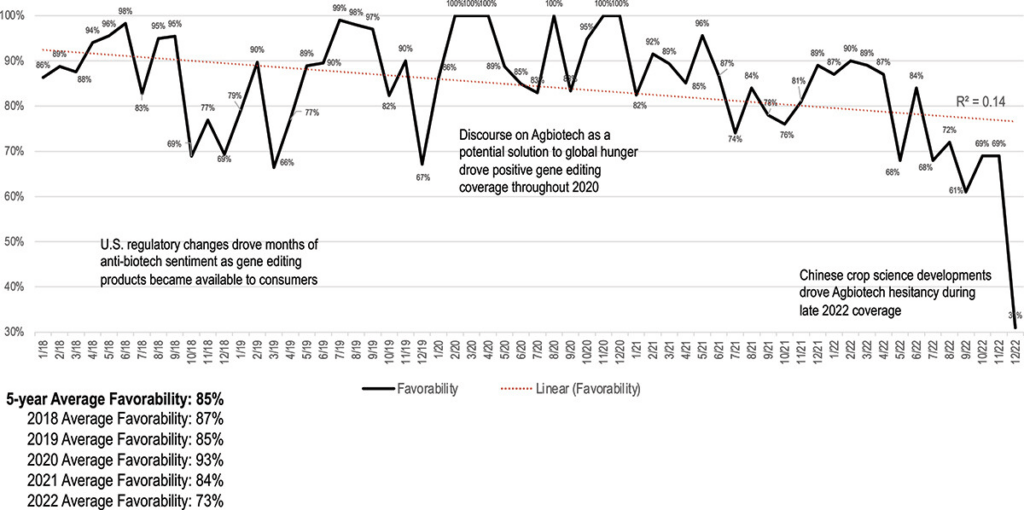
Figure 3 shows the same data on gene editing favorability in traditional media as Figure 2, but plotted alongside favorability analysis of GMOs for comparative purposes during the same time period and using the same methods. It can be seen, in support of our starting hypothesis, that the sentiment of traditional media coverage on GMOs is consistently – though not exclusively – less favorable than that of gene editing. This confirmation of our anecdotal observations surrounding the GMO/gene editing media debates we believe helps to validate the machine/automated analytical methods employed here.
Figure 3. Favorability analysis of traditional media coverage of gene editing and GMOs 2018–2022. GMO sentiment is indicated by the dashed line.

It is notable too that there are also no occasions with 100% positive favorability coverage of GMOs, which has been the case for gene editing, particularly through 2020. Although we have not performed a statistical analysis of the relationship between the two lines, a visual inspection indicates that the peaks and troughs do match on various occasions, suggesting that media coverage of gene editing and GMOs is not completely separated. Note also that the trendlines for both GMOs and gene editing show a relatively strong downward trend for the entire 5-year period as evidenced by high R2 numbers. Interestingly, the trendline slopes for both issue areas are almost exactly the same.
Figure 4 shows the same plot as Figure 2, but for social media favorability rather than traditional/online media. This is a combination of Facebook page posts and comments, and Twitter posts and retweets. Note the upward trend, contrasting with the downward trend in traditional media favorability, with the trendline exhibiting an even higher R2 number than in Figure 2. Again the headlines are illustrative only. On an annualized basis the trend is also clear, with 2018 anomalously low in favorability terms, and 2022 anomalously high, with a striking 94% overall favorability. The 5-year average for social media favorability of gene editing is 83%, as compared to a 5-year average traditional media favorability for gene editing of 85%, almost the same value.
Figure 4. Favorability analysis of social media coverage of ag-biotech gene editing 2018–2022.
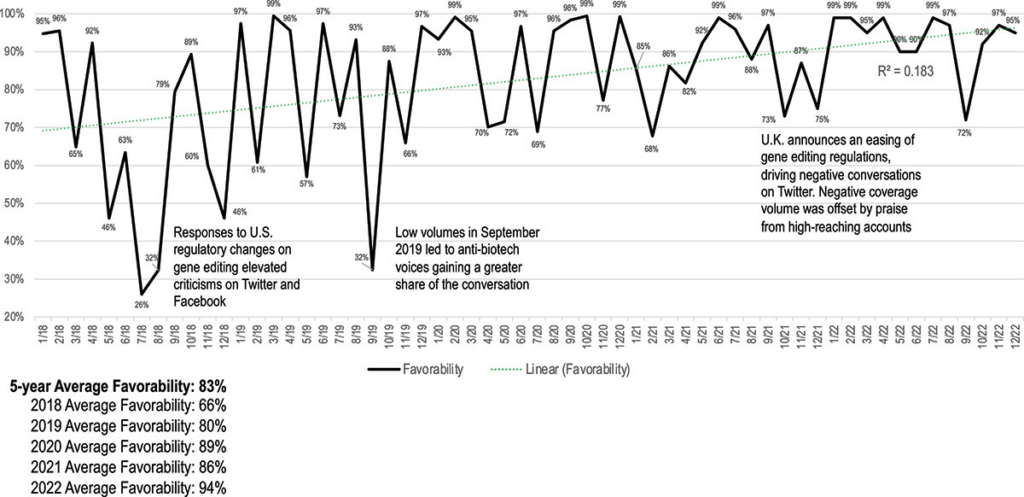
Figure 5 shows the top 10 traditional media outlets by reach in our analysis, and the top social media influencers. Note the substantial overlap, in that the top traditional media outlets are heavily represented on social media with accounts with the highest reach on our issues, so the conversations are not entirely distinct. Note also the substantial reach of Chinese state-owned outlets, particularly in social media, with CGTN (China Global Television Network), Xinhua News and CCTV all in the top 10, and China Daily in the top 10 of traditional media outlets also. To our knowledge, this has not been noted elsewhere, and indicates the increasing penetration of English-language Chinese state media internationally.
Figure 5. Top 10 traditional media outlets and top 10 social media outlets by reach.
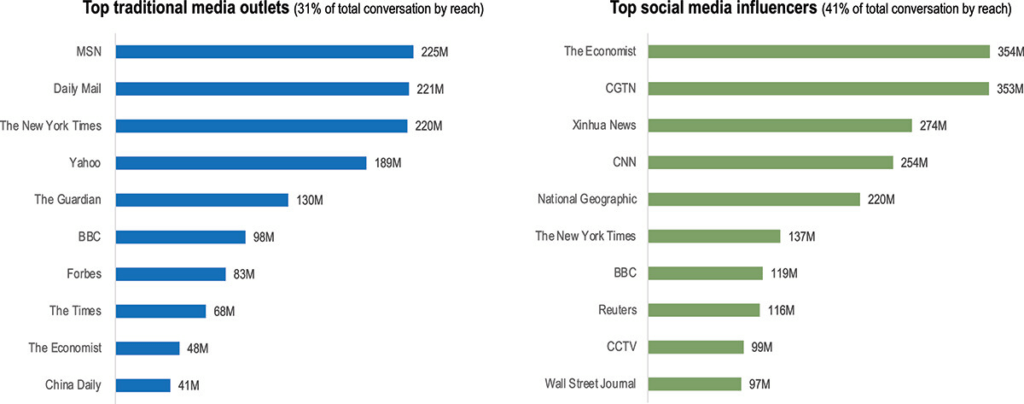
Figure 6 shows the same data on gene editing favorability in social media as Figure 4, but plotted alongside favorability analysis of GMOs for comparative purposes during the same time period and using the same methods. (Our analysis considers ag-biotech gene editing only, not medical or other uses.) It is evident that as is the case with traditional media coverage, the social media conversation on gene editing is substantially more positive than that for GMOs. This again lends support to our starting hypothesis.
Figure 6. Favorability analysis of social media coverage of gene editing and GMOs 2018–2022. GMO sentiment is indicated by the red dashed line.
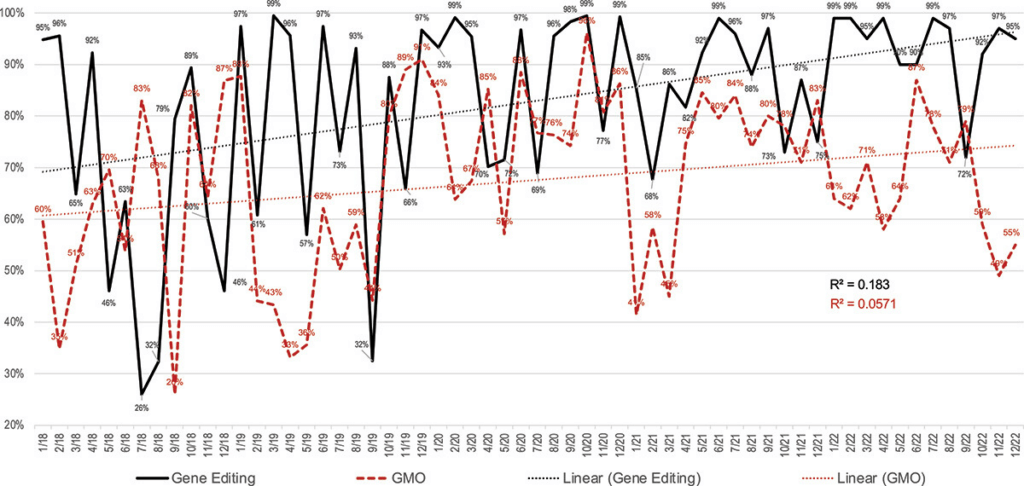
To give an indication of the combined media (traditional/online and social) favorability of gene editing vs GMOs, Figure 7 shows a plot of all the data for the 2018 to 2022 period. Note that because the trendlines for social media favorability are up for this 5-year period, while the trendlines for traditional media favorability are down, these trends more or less cancel each other out and when the media types are combined there is no significant trend evidenced over the time period of our analysis.
Figure 7. Combined (social and traditional) media favorability analysis of gene editing and GMOs for 2018–2022.
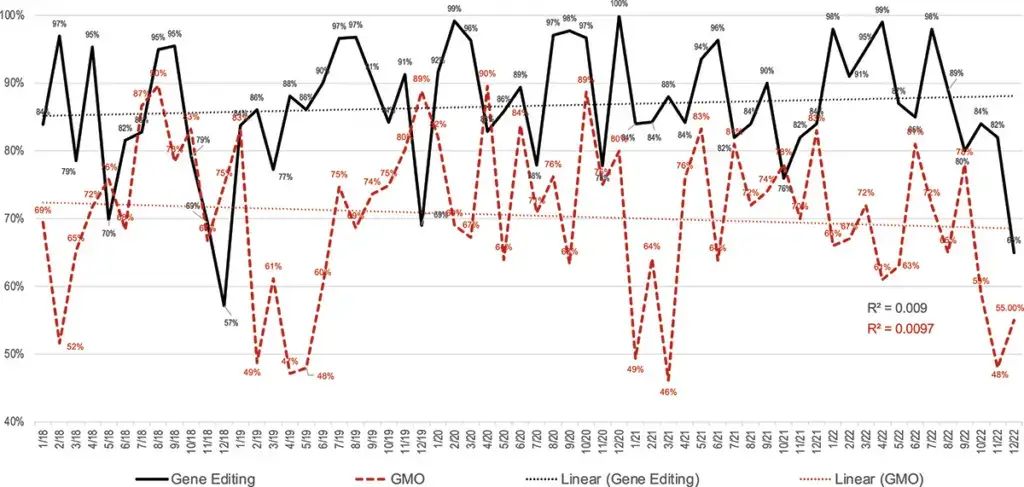
Discussion
As well as presenting novel data on the gene editing media conversation, we hope our study provides a useful update on our previously published work focusing solely on GMOs in the media (Evanega et al, 2022.Citation1) While our earlier work evaluated 3 years of data (2018–2020) the data published here extend this for an additional two-year period, making 5 continuous years in total. We can therefore make some comparative observations on the results of the two pieces of work that might help provide additional context to analyze our earlier conclusions.
In particular, while we tentatively concluded in our earlier paper that GMOs had seen a trend toward higher favorability between January 2018 and December 2020, this trend does not seem to have continued in the subsequent 2 years, out to the end of 2022. This comparison shows – as has been observed many times before – that trendline analyses are highly sensitive to start/end dates, illustrated in this case by a sudden dip in GMO favorability sentiment (evidenced in social, traditional, and combined media) which took place just after our previous analysis ended, namely in the first quarter of 2021. This period saw the lowest GMO combined media favorability of the entire 5-year period, and although the monthly trendline thereafter returned to more “normal” levels, this – alongside another notable dip in November 2022 _ pushed the overall 5-year trendline down, while the previous 3-year trendline was up.
We believe therefore that the 5-year trendlines for this analysis should be viewed with caution, in the absence of any very strong trend – sustained over time – in any particular direction. Monthly values, particularly in social media, are very variable, meaning that 5-year trendlines are especially sensitive to start-end dates – which it should be noted are arbitrary in our case, based on the period of time we chose to carry out this study rather than any exogenous factors. The reason that monthly values are variable is because of the nature of media, where different stories break and contain essentially negative or favorable narratives according to the content of each. Thus, while traditional media stories about crop gene editing as a solution to global hunger were associated with favorability peaks during 2022, negative coverage of ag-biotech in China drove favorability to a very low level at the end of our analysis in December 2022. To emphasize our previous point, if we had ended our analysis a month earlier, before this low point, the 5-year trendline would have no doubt appeared much more positive.
More robust therefore is the very consistent difference between favorability of gene editing and GMOs, which is seen in all media over virtually the entire 5-year period, with gene editing enjoying substantially higher favorability ratings than GMOs. Although explaining this differential is outside the scope of this study, we would speculate that this could be the result of the relative novelty of gene editing as an issue, which has not – unlike GMOs – been the subject of a decades-long campaign of negative publicity by opponents. Although anti-GMO activists do tend to also oppose gene editing technologies (often characterizing them as “GMO 2.0” for example) this has not yet gained traction with the general public. It is also possible that the scientific community has learned from its mistakes in the early deployment of GMOs and has made efforts not to repeat them as gene editing is used more extensively.Citation10 It may also be the case that gene editing – which largely involves DNA alterations that could possibly happen in nature – is less inherently “scary” than transgenic techniques transferring DNA sequences between unrelated species. Gene editing also does not have the “Monsanto factor” of a highly visible stakeholder in the sector which suffers from very negative perceptions and publicity, or an association with negative environmental attributes like increased herbicide use.
It is also notable, notwithstanding our cautionary points above regarding the reliability of trendlines, that social media coverage of gene editing has been surprisingly positive over a long period of time even as it has been reaching substantially bigger audiences. Negative accounts with less visibility are tending to be drowned out by huge media companies with massive social reach, which will likely continue publishing neutral, favorable content. This contradicts often-heard statements about how social media in general tends to be negative and polarizing: our analysis suggests the opposite, that social media on this new technology at least has been very positive over a long period of time, with peaks showing almost entirely favorable coverage in individual months over the entire 5-year period of our data.
Conclusion
Our data show that both traditional and social media coverage of agricultural gene editing has been substantially more positive than that of GMOs over a five-year period. We believe that the scientific community can therefore take some heart from this finding in the sense that the battle for public opinion has not been lost to anti-science activists as has arguably been the case at some times on genetically modified crops and foods. While it is clear from our analysis that time trendlines for such noisy data as we present here should be taken with caution, on a month-to-month basis the favorability ratings of both gene editing and GMOs are highly dependent on specific storylines that break in the media. Assuming there are no long-term and very negative stories looming in the future, based on our findings we can be cautiously optimistic that gene editing will be accepted by the public and can live out its promise of making a substantial contribution to future food security and environmental sustainability. However, there are some recent indications of more sustained downward trends, which may be cause for future concern.
Karen Stockert is an analyst for Cision Insights. Follow Karen on Twitter @VTInsightsKaren
Mark Lynas is an activist, environmentalist and author. Follow Mark on Twitter @mark_lynas
Selene Adams is consultant for Cision Insights. Follow Selene on Linkedin































